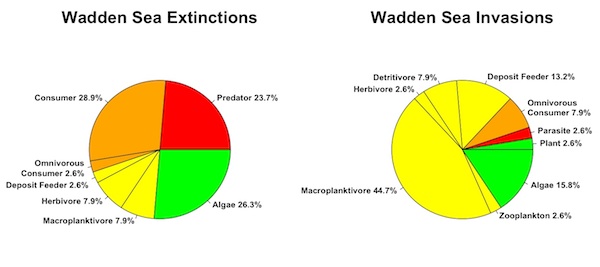Global environmental change is reshaping food webs through increased rates of extinction and invasion. But how? What kinds of species are winning, and what kinds are losing? How will climate change, overharvesting, habitat fragmentation, urbanization, and more interact to create the food webs of the future? I am interested in examining both global patterns of change to food webs as well as examining how environmental drivers shape food webs at local spatial scales.
How is biodiversity changing?
In an analysis of global and regional trends, I have shown that most species driven extinct have been top predators whereas invasive species are primary consumers. This pattern is consistent both at the scale of a single ecosystem and across the globe. To think about it geometrically, extinctions and invasions are acting together to change the shape of food webs from classical pyramids down to squat boxes.

Kelp forests where no kelp was removed (top) versus two years of winter kelp removal (bottom).
What drives shifts in trophic structure?
Beyond just documenting patterns, I’m interested in asking why. Why are food webs shifting? What is driving these shifts? How universal are the drivers of change in food web structure?
For example, at the Santa Barbara Coastal LTER, I examined how climate change driven increases in the annual frequency of intense storms in the Southern California could change structure of kelp forest food webs. Giant kelp acts as a foundation species, providing habitat and food for many species, as well as determining the balance between algae and sessile invertebrates by reducing light on rocky reefs.
Through an analysis of long-term biological, oceanographic, and satellite data, I found that the loss of kelp by storm-driven waves increases algal diversity but decreases diversity at all other trophic levels. Simulating these results through time, I showed that annual large storms should ultimately simplify the network structure of kelp forest food webs. While these results were derived from structural equation models and simulations, they were still based on correlative evidence. I therefore verified these predictions using early results from a large-scale kelp removal experiment that we have set to run for the next decade. With the LTER, I am beginning to examine how this experimental kelp removal and concomitant changes in food web structure lead to shifts in the allocation of biomass between different compartments of the food web.
This is just one example. In the Byrnes lab, we’re interested in looking at the causes and consequences of shifts in food web structure at both the global and local scale.
Relevant references
Byrnes, J.E., Reed, D.C., Cardinale, B.J., Cavanaugh, K.C., Holbrook, S.J., and Schmitt, R.J. 2011. Climate driven increases in storm frequency simplify kelp forest food webs. Global Change Biology. 17: 2513-2524. [doi] [pdf]
Byrnes, J.E., Reynolds, P.L., Stachowicz, J.J. 2007. Invasions and extinctions reshape coastal marine food webs. PLoS One. 2: e295. [doi] [pdf]


